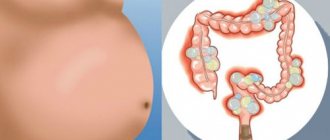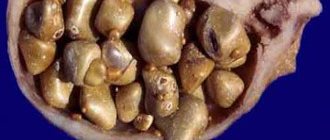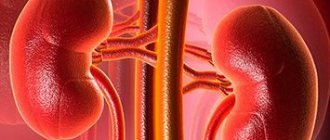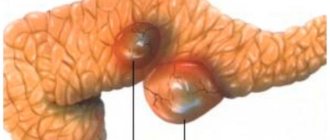Dropsy (dropsy) is a pathological process based on the accumulation of transudate in the interstitial space or subcutaneous tissue. Dropsy is not an independent disease; it is one of the symptoms characteristic of pathologies of the kidneys, heart, liver, and endocrine glands.
Dropsy of the abdomen
What kind of disease is this?
Dropsy is swelling; the accumulation of transudate can occur in different organs or throughout the body, which determines the type of pathology. As a result of impaired outflow, the skin begins to swell. The contents of the edema are a clear liquid with a high protein content. Despite the fact that a person is 80% water, its stagnation is dangerous. The causes, symptoms and treatment of dropsy depend on its location. During the treatment process, regardless of the primary disease, it is recommended to eat foods low in protein and reduce water intake.
Symptoms
The symptoms for all types of dropsy are almost the same. Adults tolerate this disease more easily. In children, it is necessary to carry out proper and timely treatment so that no complications arise in the future. It is necessary to know the first signs of dropsy in order to deliver a child or adult to a medical facility in a timely manner.
Main symptoms:
- the skin swells;
- at the location of the edema, the patient feels pain that is aching in nature;
- the skin over the swelling is shiny, dry and smooth;
- if you press with your finger at the location of the edema, the hole will not level out for a long time;
- strong thirst;
- feeling of heaviness;
- dyspnea;
- In men, testicular hydrocele will be accompanied by severe nagging pain. The patient notes that the scrotum is swollen;
- In a child with dropsy of the spermatic cord or testicle, the body temperature may rise to high levels.
Reasons for appearance
Signs of dropsy are different, depending on the form they can be as follows.
| Type of dropsy | Causes |
| Hydrocele | Tumors, mechanical damage, inflammation, gonorrhea, tuberculosis. |
| Dropsy of pregnancy | Disturbances in water-salt balance and capillary circulation resulting from changes in the neuroendocrine regulation of biochemical processes |
| Hydrothorax | Tumor in the mediastinum, diseases of the genitourinary system, dystrophy due to vitamin deficiency, disorders of lymphatic drainage. |
| Hydropericardium | Diseases of the heart muscle, oncology, tuberculosis, myxidema. |
| Hydrarthrosis | Mechanical damage to the meniscus, ankylosing spondylitis, syphilis, tuberculosis. |
| Ascites | Heart failure, dystrophy, kidney disease, tuberculosis, oncology, portal vein thrombosis. |
| Hydrocephalus | Underdevelopment of the brain, spina bifida, cancerous and parasitic brain lesions, meningitis, encephalitis, skull damage. |
| Hydrocele of the gallbladder | The presence of stones, chronic cholecystitis, biliary dyskinesia, abnormal structure of the gallbladder. |
| Hydrocele of the lacrimal sac | Dacryocystitis. |
| Hydrosalpinx | Intrauterine device, abortion with curettage, frequent hypothermia, inflammation, infections, frequent change of sexual partners, myomatous nodes, underdevelopment of the genital organs, endocrine disorders, dysbacteriosis. |
| Ovarian cystoma | True signs of ovarian hydrocele have not been identified; it is believed that the pathology can be provoked by: · papilloma virus and herpes type 2; · hormonal disorders of ovarian function; · abortions; · ectopic pregnancy; · operations; · breast oncology; · irregular menstrual cycle and some other female diseases. |
| Funiculocele | The pathology may be congenital or result from: · injuries; · inflammation in the scrotum; · varicocele; · neoplasms; · influx of venous blood during puberty. |
| Hydronephrosis | Urolithiasis, tumors, structural abnormalities of the genitourinary system. |
| Hydrophthalmos | The disease is congenital, hereditary, resulting from the closure of the angle of the anterior chamber by embryonic tissue, underdevelopment of the venous sinus of the sclera. |
| Hemolytic disease of the newborn | Incompatibility of blood between mother and child. |
Congenital hydrocele
This disease occurs in newborn babies. The reason is pathologies of embryonic development. The immune form of hydrops in a newborn is more rare. The non-immune form develops with various viral infections, congenital syphilis, inflammation of the placenta, heart defects, and chromosomal abnormalities. But in many cases, specialists are unable to determine the reasons for the development of dropsy in newborns. This condition requires immediate treatment, as irreversible changes in the body may occur that are dangerous to the health and life of the child. Symptoms of the disease appear immediately after birth.
Types of dropsy
Pathology is divided into 2 forms. With general dropsy, the entire body is susceptible to edema, starting from the face and moving to the legs; with heart failure, swelling begins in the lower extremities, and a person develops “elephant feet” syndrome. Local dropsy is characterized by damage to one organ; depending on the location, it has several varieties:
- dropsy of pregnant women, newborns and false;
- ascites;
- hydrophthalmos;
- hydrocephalus;
- hydrothorax;
- hydrocele;
- hydropericardium;
- hydronephrosis;
- funiculocele
- hydrarthrosis;
- hemolytic disease of newborns;
- ovarian cystoma;
- hydrosalpinsk;
- hydrocele of the gallbladder;
- dropsy of the lacrimal sac.
Pathology is also distinguished into:
- Mechanical, which is caused by high hydrostatic pressure in small blood vessels due to blockage or physical pressure.
- Hypooncotic, which appears as a result of a decrease in protein levels in the blood.
- Membranogenic, occurring against the background of acute nephritis, cardiac or respiratory failure, and others.
- Lymphatic, provoked by impaired lymph circulation.
Symptoms of ascites
Clinically, dropsy does not appear immediately. This usually takes several months, which significantly complicates timely diagnosis. Because patients think that they have only gained a few extra pounds.
Signs of abdominal dropsy may include:
Main signs of heart failure. Ascites is shown in the center of the picture.
- Abdominal pain.
- Intestinal dysfunction, development of flatulence, possible constipation or, conversely, diarrhea.
- Frequent attacks of heartburn and belching.
- With liver pathology, symptoms are expressed in a feeling of bitterness and a metallic taste in the mouth, yellowness.
- Swelling in the legs.
- Lymph nodes enlarge.
- Kidney swelling, difficulty urinating.
- Shortness of breath and heavy breathing.
As fluid accumulates, the abdomen increases in size and resembles a ball. Stretch marks may form and veins may dilate. If the fluid pinches the liver walls of blood vessels, the person develops jaundice.
Treatment methods
The acute form is treated with medications, anti-inflammatory and painkillers, cold and warm compresses, and wearing a suspension are prescribed. In the case of a chronic course, use:
- A puncture that involves removing the contents with a syringe. The procedure is effective when the patient needs emergency care, the disadvantage is that the fluid can accumulate again.
- Hydrocortisone injections promote scarring of the membranes.
- Surgical treatment is performed using general or local anesthesia. The essence of the procedure is to make punctures to remove the contents and install a drainage system.
It is impossible to cure edema without eliminating the primary pathology, otherwise they will appear again.
Hydrocele of the spermatic cord
Hydrocele of the spermatic cord is called funiculocele. The clinical picture of the disease is the same as with hydrocele, only fluid accumulates along the spermatic cord.
Funiculocele
The spermatic cord is a paired anatomical formation that is located between the internal inguinal ring and the testicle. Dropsy edema of this organ occurs in most cases due to injury. In the acute form of the disease, the child develops a high fever and severe pain in the scrotum area. The skin turns red and becomes swollen. If you palpate, you can feel an elastic, oval-shaped body that is not connected to the testicle. Treatment of dropsy in the presence of these symptoms must be carried out immediately.
In adult men and children, the causes of hydrocele of the spermatic cord differ significantly. Dropsy in newborns and children under three years of age is associated with the anatomical features of the body. The main reason for fluid entering the scrotum is the presence of a communicating canal. Often in the first year of life in boys, hydrocele of the spermatic cord goes away on its own. Surgical treatment of dropsy according to indications should only be carried out in a child over three years of age.
In men, hydrocele of the spermatic cord develops due to:
- injuries to the external genitalia (including the spermatic cord);
- tumors of the testicle and spermatic cord;
- inflammation of the scrotal organs;
- operations due to varicocele (dilation of the veins of the spermatic cord).
ethnoscience
Treatment of dropsy with traditional medicine is permissible in combination with basic therapy and after medical consultation. The following recipes are used in the fight against pathology:
- Black radish. Black radish juice with honey is considered effective in treatment. Initially, the daily dose of the medicine is 1/3 cup, after some time it is increased to 500 ml.
- Grape. Treatment consists of eating 10 fresh grapes in the morning, after which food intake should begin as late as possible.
- Nettle. Traditional healers recommend drinking tea from nettle roots. To prepare it you need 1 small spoon of raw materials per 250 ml of boiling water. The daily dose is 500 ml, drink 1 glass of tea in the morning and evening.
Hydrocele of the testicle
In medicine, this disease is called “hydrocele.” In boys, hydrocele can be congenital or acquired. In a newborn baby, dropsy is diagnosed only in 5–10% of cases. The cause of the pathology is intrauterine development disorders. The formation of testicles in boys occurs in the abdominal cavity. They then travel a long way and are placed in the scrotum. This process occurs gradually. As they descend into the scrotum, the testicles pull the abdominal membrane along with them. As a result, a tissue funnel is formed. It usually heals before birth, but in some babies this does not happen. Through this peculiar “path”, the liquid enters the scrotal tissue and edema develops. In this case, the pathology must be treated.
In the first months of life, boys do not show symptoms of hydrocele, since the child most often just lies down and little fluid enters the scrotum. Hydrocele of the testicle is detected at one or one and a half years, when the child begins to walk. Treatment for dropsy is only surgical. Such intervention is necessary to eliminate the risk of complications.
Disease prevention
In order to prevent dropsy, pregnant women should eat properly, establish a work and rest schedule, prevent toxins from entering the body, strengthen the immune system to reduce the risk of infections, and undergo regular examinations.
In order to prevent organ dropsy, it is necessary to promptly treat all diseases that can provoke it, and be careful to prevent injuries to the scrotum and skull.
Hydrocele in pregnant women
Hydrops of pregnancy most often develops in the second half of pregnancy. This is due to the fact that a lot of sodium accumulates in a woman’s body, which retains water in the tissues. The presence of pathology should be discussed if the weight of a pregnant woman has increased by more than 20 kg and her face, arms, legs and lower back are severely swollen. These symptoms indicate that this is already hydrops of pregnancy, which needs to be treated. The causes of its development can be kidney disease, endocrine disorders, liver disease, and hypertension. Treatment of dropsy must begin with treatment of the disease that provoked its development.
Dropsical edema does not have a negative effect on the unborn child. But treatment will be necessary, since dropsy can develop into a severe form of gestosis. The pregnant woman will be advised to reduce the amount of fluid she takes. Doctors often prescribe a course of vitamins. As a rule, dropsy in pregnancy goes away with this treatment. The first symptoms of recovery are increased diuresis and improved appetite.
Forecast
Ascites in cancer significantly worsens the general well-being of the patient. As a rule, such a complication occurs in the later stages of oncology, in which the survival prognosis depends on the nature of the tumor itself and its distribution throughout the body.
Life expectancy with ascites depends on the following factors:
- Functioning of the kidneys and liver;
- Activities of the cardiovascular system;
- The effectiveness of therapy for the underlying disease.
The development of ascites can be prevented by an experienced doctor observing the patient. Doctors at the Yusupov Hospital have extensive experience in dealing with various types of cancer. Qualified medical personnel and the latest equipment allow for accurate diagnosis and high-quality, effective treatment in accordance with European standards.
How dangerous is the accumulation of fluid in the abdomen?
This is primarily determined by the underlying disease. Cirrhosis and oncopathologies are dangerous in themselves, and ascites aggravates their course and negatively affects the effectiveness of treatment. Complications may occur: spontaneous bacterial peritonitis , hepatorenal syndrome (severe renal dysfunction). At the same time, the prognosis worsens. Read more about fluid in the abdominal cavity during oncology.
Dropsy on the legs and arms in the elderly, adults and children: symptoms
If dropsy of the limb appeared only once and went away on its own, most likely it was a physiological reaction. If the arms and legs swell systematically, the swelling gets worse, we are definitely talking about pathology, and you should definitely consult a doctor. Here are the symptoms of dropsy that should alert you:
- Both or one of the limbs swells locally at once.
- The swollen area feels like dough to the touch.
- The skin on the swollen area is glossy, stretched, pale and loose, and bluish. If trophic skin changes appear on it, this indicates a severe degree of edema.
- When you press on the swollen area, a dimple-dent remains on it.
A pit on the skin on palpation of dropsy.
Our doctors
Khromov Danil Vladimirovich
Urologist, Candidate of Medical Sciences, doctor of the highest category
35 years of experience
Make an appointment
Perepechay Dmitry Leonidovich
Urologist, Candidate of Medical Sciences, doctor of the highest category
40 years of experience
Make an appointment
Kochetov Sergey Anatolievich
Urologist, Candidate of Medical Sciences, doctor of the highest category
34 years of experience
Make an appointment
Mukhin Vitaly Borisovich
Urologist, Head of the Department of Urology, Candidate of Medical Sciences
34 years of experience
Make an appointment











